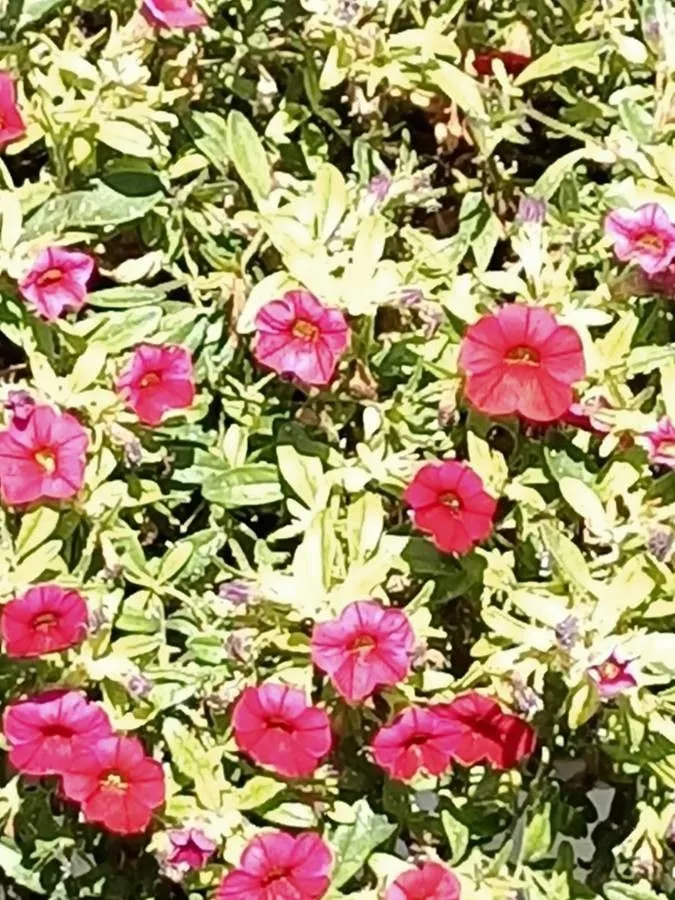
Author: Hook.
Bibliography: Bot. Mag. 62: t. 3441 (1835)
Year: 1835
Status: accepted
Rank: species
Genus: Phlox
Vegetable: False
Observations: C. & SE. U.S.A.
Drummond’s phlox, known scientifically as Phlox drummondii, is a vibrant and eye-catching species belonging to the Polemoniaceae family. First described in 1835 by Hook., this plant has captured the attention of botanists and garden enthusiasts alike, thanks to its brilliant colors and hardiness.
Drummond’s phlox showcases an array of bright and beautiful flowers that come in shades of pink, red, lavender, and white, often with contrasting throats or centers. These flowers, typically measuring around an inch in diameter, form clusters that create a dense and colorful display. The plant itself is relatively compact, usually growing to a height of about 12-15 inches, making it ideal for borders, containers, and rock gardens.
Native to the central and southeastern regions of the United States, Drummond’s phlox thrives in well-drained soils and sunny locations. It is frequently found in meadows, prairies, and open woodlands where it can take advantage of full sun to partial shade conditions. The plant is quite versatile and can tolerate a range of soil types, although it prefers sandy or loamy soils with good drainage.
Gardening enthusiasts favor Drummond’s phlox not only for its stunning visual appeal but also for its relatively easy cultivation. Here are some key aspects of growing and maintaining this plant:
Drummond’s phlox is used extensively in ornamental gardening. Its bright flowers make it a stunning addition to garden beds and borders. Moreover, its relatively short stature and bushy growth habit make it perfect for container gardening and hanging baskets. Beyond visual appeal, the flowers attract a variety of pollinators, including butterflies and bees, adding ecological value to its ornamental use.
While Drummond’s phlox is generally a hardy plant, it does face challenges from pests such as aphids and spider mites. Regular monitoring and appropriate treatments can help manage these issues. Additionally, ensuring good air circulation around the plants can prevent common fungal diseases like powdery mildew.
In summary, Drummond’s phlox (Phlox drummondii) is a remarkably beautiful and easy-to-grow plant that can add a splash of color to any garden. Its adaptability to a range of environments and straightforward care requirements make it a favorite among both novice and experienced gardeners. Whether used in garden beds, containers, or as a pollinator-attracting specimen, this plant is sure to delight.
Eng: drummond’s phlox, annual phlox, pride-of-texas
Deu: sommer-phlox, stauden-phlox
Hun: egynyári lángvirág
Por: flocos, flox
Ces: plamenica drummondova, plamenka drummondova
Swe: sommarflox
Fra: phlox de drummond
En: Drummond’s phlox, Annual phlox, Pride-of-Texas, Drummond phlox
Af: Floksie
Ar: قبس دروموندي
Hy: Բոցենի միամյա
Zh: 福祿考, 福禄考
Hr: Plameni cvijet
Cs: Plamenka Drummondova, Plamenica Drummondova
Et: Suvi-leeklill
Fi: Kesäleimu
Fr: Phlox de Drummond
De: Sommer-Phlox, Stauden-Phlox
Hu: Egynyári lángvirág
Ja: Kikyō-nadeshiko
Fa: فلوکس
Pl: Floks Drummonda
Pt: Flocos, Flox
Ru: Флокс Друммонда
Sv: Sommarflox
Zh-tw: 福祿考
Zh-hant: 福祿考
Taken Mar 17, 2020 by Nyezh Simim (cc-by-sa)
Taken Oct 21, 2021 by Praveenkumar Honnur (cc-by-sa)
Taken Jun 24, 2021 by Chris Harry (cc-by-sa)
Taken Feb 26, 2022 by Yathish Rao (cc-by-sa)
Taken Oct 15, 2020 by FERREIRA DIEGO CÉSAR (cc-by-sa)
© copyright of the Board of Trustees of the Royal Botanic Gardens, Kew.
© copyright of the Board of Trustees of the Royal Botanic Gardens, Kew.
© copyright of the Board of Trustees of the Royal Botanic Gardens, Kew.
Taken Nov 7, 2019 by Benjamin Hoppo (cc-by-sa)
Taken Aug 29, 2021 by Marc Tremblay (cc-by-sa)
Taken Aug 14, 2020 by Carvalho Leandro (cc-by-sa)
Taken Jul 24, 2021 by Gwendolynn (cc-by-sa)
Taken Jul 8, 2021 by j t (cc-by-sa)
Taken Mar 22, 2014 by EOL − James Mickley (cc-by-nc)
Taken Apr 23, 2015 by EOL − samanthamarie (cc-by-nc)
Taken Apr 12, 2015 by EOL − Linda Jo Conn (cc-by-nc)
Taken Jul 12, 2020 by Émilie Chapellier (cc-by-sa)
Taken Jan 1, 1900 by EOL − Niehaus, T.F. (cc-by-nc-sa)
Taken Jul 18, 2020 by Giode Tonpino (cc-by-sa)
Taken Jun 10, 2012 by selber pflanzen (cc-by-sa)
Taken Jul 14, 2022 by Modi Elnadi (cc-by-sa)
Taken May 5, 2022 by Maria do Mar Mar (cc-by-sa)
Taken Jan 1, 1900 by EOL − Niehaus, T.F. (cc-by-nc-sa)
Growth habit>: Forb/herb
Family: Myrtaceae Author: (F.Muell.) K.D.Hill & L.A.S.Johnson Bibliography: Telopea 6: 402 (1995) Year: 1995 Status:…
Family: Rubiaceae Author: Pierre ex A.Froehner Bibliography: Notizbl. Bot. Gart. Berlin-Dahlem 1: 237 (1897) Year:…
Family: Sapindaceae Author: Koidz. Bibliography: J. Coll. Sci. Imp. Univ. Tokyo 32(1): 38 (1911) Year:…
Family: Asteraceae Author: A.Gray Bibliography: Pacif. Railr. Rep.: 107 (1857) Year: 1857 Status: accepted Rank:…
Family: Fabaceae Author: Medik. Bibliography: Vorles. Churpfälz. Phys.-Ökon. Ges. 2: 398 (1787) Year: 1787 Status:…
Family: Aspleniaceae Author: (Cav.) Alston Bibliography: Bull. Misc. Inform. Kew 1932: 309 (1932) Year: 1932…